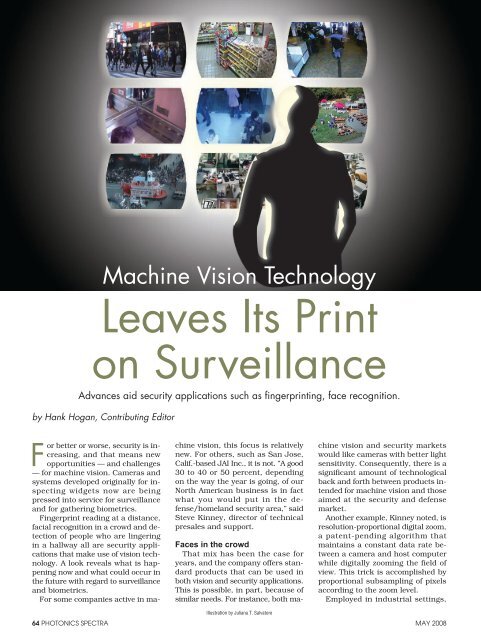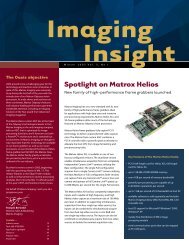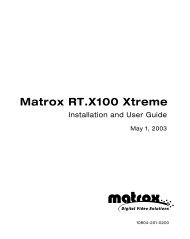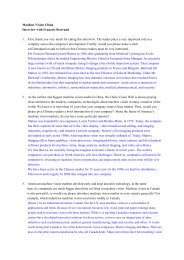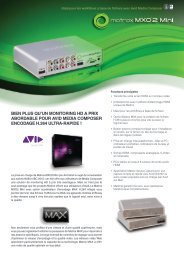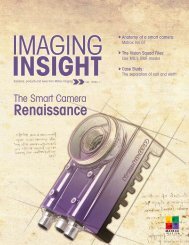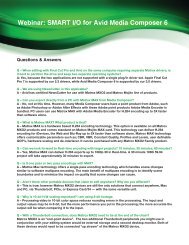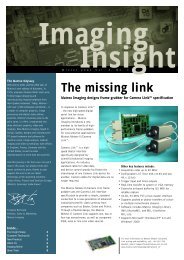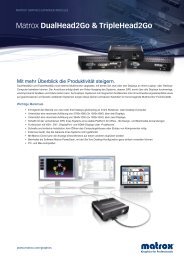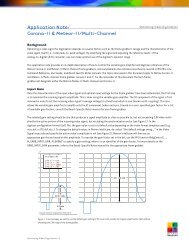Machine Vision Technology Leaves Its Print on Surveillance - Matrox
Machine Vision Technology Leaves Its Print on Surveillance - Matrox
Machine Vision Technology Leaves Its Print on Surveillance - Matrox
You also want an ePaper? Increase the reach of your titles
YUMPU automatically turns print PDFs into web optimized ePapers that Google loves.
<str<strong>on</strong>g>Leaves</str<strong>on</strong>g> <str<strong>on</strong>g>Its</str<strong>on</strong>g> <str<strong>on</strong>g>Print</str<strong>on</strong>g><br />
<strong>on</strong> <strong>Surveillance</strong><br />
Advances aid security applicati<strong>on</strong>s such as fingerprinting, face recogniti<strong>on</strong>.<br />
by Hank Hogan, C<strong>on</strong>tributing Editor<br />
For better or worse, security is increasing,<br />
and that means new<br />
opportunities — and challenges<br />
— for machine visi<strong>on</strong>. Cameras and<br />
systems developed originally for inspecting<br />
widgets now are being<br />
pressed into service for surveillance<br />
and for gathering biometrics.<br />
Fingerprint reading at a distance,<br />
facial recogniti<strong>on</strong> in a crowd and detecti<strong>on</strong><br />
of people who are lingering<br />
in a hallway all are security applicati<strong>on</strong>s<br />
that make use of visi<strong>on</strong> technology.<br />
A look reveals what is happening<br />
now and what could occur in<br />
the future with regard to surveillance<br />
and biometrics.<br />
For some companies active in ma-<br />
<str<strong>on</strong>g>Machine</str<strong>on</strong>g> <str<strong>on</strong>g>Visi<strong>on</strong></str<strong>on</strong>g> <str<strong>on</strong>g>Technology</str<strong>on</strong>g><br />
chine visi<strong>on</strong>, this focus is relatively<br />
new. For others, such as San Jose,<br />
Calif.-based JAI Inc., it is not. “A good<br />
30 to 40 or 50 percent, depending<br />
<strong>on</strong> the way the year is going, of our<br />
North American business is in fact<br />
what you would put in the defense/homeland<br />
security area,” said<br />
Steve Kinney, director of technical<br />
presales and support.<br />
Faces in the crowd<br />
That mix has been the case for<br />
years, and the company offers standard<br />
products that can be used in<br />
both visi<strong>on</strong> and security applicati<strong>on</strong>s.<br />
This is possible, in part, because of<br />
similar needs. For instance, both ma-<br />
chine visi<strong>on</strong> and security markets<br />
would like cameras with better light<br />
sensitivity. C<strong>on</strong>sequently, there is a<br />
significant amount of technological<br />
back and forth between products intended<br />
for machine visi<strong>on</strong> and those<br />
aimed at the security and defense<br />
market.<br />
Another example, Kinney noted, is<br />
resoluti<strong>on</strong>-proporti<strong>on</strong>al digital zoom,<br />
a patent-pending algorithm that<br />
maintains a c<strong>on</strong>stant data rate between<br />
a camera and host computer<br />
while digitally zooming the field of<br />
view. This trick is accomplished by<br />
proporti<strong>on</strong>al subsampling of pixels<br />
according to the zoom level.<br />
Employed in industrial settings,<br />
Illustrati<strong>on</strong> by Juliana T. Salvatore<br />
64 PHOTONICS SPECTRA MAY 2008
MAY 2008<br />
Security Imaging<br />
It is important to get the full surveillance picture without causing data overload. On the left is a full-resoluti<strong>on</strong>, full-field-of-view<br />
shot of a highway. This 4-megapixel image at 15 fps at an 8-bit gray scale is more than 60 MB/s — too much for most wireless<br />
c<strong>on</strong>necti<strong>on</strong>s or a multicamera wired network. In the middle is the same shot, with every fourth pixel and fourth row. The road<br />
and vehicles still can be seen, but the bandwidth is less than 8 Mb/s. On the right is a digitally zoomed image, with all pixels<br />
present in a 4� smaller field of view. Again, the bandwidth is less than 8 Mb/s. Courtesy of JAI.<br />
the applicati<strong>on</strong> could enable verificati<strong>on</strong><br />
of a part’s placement followed<br />
by zooming in to capture an identificati<strong>on</strong><br />
mark. In surveillance, the<br />
technique could allow an airborne<br />
camera’s operator to spot a truck<br />
and then zoom in <strong>on</strong> its details, without<br />
overloading the data link.<br />
In general, better imaging across<br />
more wavelengths improves surveillance.<br />
For example, defense c<strong>on</strong>tractor<br />
ICx Imaging Systems of<br />
Apopka, Fla., offers products that<br />
combine video in the visible with<br />
thermal imaging. A thermal imager<br />
can determine whether an engine<br />
block <strong>on</strong> a car is hot, and a visible<br />
sensor can see inside rolled-up windows<br />
as well as read the vehicle’s license<br />
plate.<br />
Al<strong>on</strong>e, neither capability provides<br />
the complete picture, noted ICx Imaging<br />
Systems’ general manager Nirav<br />
Pandya. However, when the two images<br />
are overlaid, all the informati<strong>on</strong><br />
can be seen in <strong>on</strong>e image. The company<br />
uses standard NTSC video cameras<br />
for its visible sensors, supplying<br />
expertise in the thermal imaging and<br />
data overlay arenas. Higher-resoluti<strong>on</strong><br />
cameras capable of working in<br />
lower light c<strong>on</strong>diti<strong>on</strong>s would add to<br />
the quality of the informati<strong>on</strong>, as<br />
would higher-resoluti<strong>on</strong> thermal<br />
imaging.<br />
One goal of surveillance is picking<br />
out faces in a crowd and at a distance,<br />
a feat that JAI’s Kinney said<br />
might be possible with a 4-megapixel,<br />
high-frame-rate camera. Such technology,<br />
however, also must account<br />
Overlaying a visible video feed with data from a thermal imager reveals hidden<br />
informati<strong>on</strong>. Here an individual shows up as a white figure, properly placed in the<br />
overall scene. Courtesy of ICx Imaging Systems.<br />
for current-day realities. Many surveillance<br />
applicati<strong>on</strong>s require lowcost<br />
equipment and l<strong>on</strong>g cable runs<br />
between a central locati<strong>on</strong> and a<br />
camera. Today analog cameras are<br />
used, but GigE <str<strong>on</strong>g>Visi<strong>on</strong></str<strong>on</strong>g>-based systems<br />
might be used in the future. However,<br />
the infrastructure required for<br />
GigE <str<strong>on</strong>g>Visi<strong>on</strong></str<strong>on</strong>g> cameras — wiring, cameras<br />
and host systems — would increase<br />
the overall cost and complexity<br />
significantly.<br />
Even with better imaging capabilities,<br />
facial recogniti<strong>on</strong> in general settings<br />
is hampered by lighting and<br />
pose variables. Recently, researchers<br />
at the University of Glasgow in<br />
the UK found that averaging photographs<br />
together doubles facial<br />
recogniti<strong>on</strong> accuracy. About half of<br />
new photos of celebrities were correctly<br />
identified by FaceVACS, the<br />
face-recogniti<strong>on</strong> technology developed<br />
by the researchers. For averaged<br />
shots, <strong>on</strong> the other hand, the<br />
success rate jumped to 100 percent.<br />
Remote fingerprints<br />
Facial recogniti<strong>on</strong> is <strong>on</strong>e form of<br />
biometrics — measurements based<br />
<strong>on</strong> identifying unique biological characteristics.<br />
Fingerprints are the bestknown<br />
and oldest biometric, but<br />
other body parts — such as the iris,<br />
retina and palm — could be used.<br />
The most basic of body parts, DNA,<br />
also has been pressed into biometric<br />
service.<br />
With fingerprints, history is both a<br />
blessing and a burden. Large databases<br />
of fingerprints collected over<br />
the decades exist worldwide, making<br />
it possible to compare what is<br />
gathered currently at ports of entry<br />
PHOTONICS SPECTRA 65
Security Imaging<br />
or crime scenes against a large<br />
gallery. However, for such comparis<strong>on</strong>s<br />
to work, what is collected today<br />
must mimic the prints made in the<br />
past by pressing an ink-stained finger<br />
against a piece of paper.<br />
That places special c<strong>on</strong>straints <strong>on</strong><br />
c<strong>on</strong>tactless digital fingerprinting,<br />
noted Erik Bowman, a principal engineer<br />
at defense c<strong>on</strong>tractor Northrop<br />
Grumman, based in Los Angeles. For<br />
example, you would need a full roll<br />
of a fingerprint, he said.<br />
The company has been working <strong>on</strong><br />
a remote fingerprint system and<br />
hopes to have a prototype ready for<br />
use this summer. The device, imaging<br />
multiple fingers from 1 or 2 m<br />
away, will capture sufficient detail<br />
in a few sec<strong>on</strong>ds. This type of system<br />
would avoid the false features<br />
sometimes introduced by flattening<br />
the finger, and it also would circumvent<br />
the problem some people<br />
have with touching a surface previously<br />
handled by thousands.<br />
The system is based <strong>on</strong> standard<br />
New technology allows fingerprints<br />
to be captured from a distance. A<br />
fingerprint captured from 30 in. (left)<br />
is compared with <strong>on</strong>e taken from a<br />
standard ink print (right). The two<br />
were matched using the NIST<br />
algorithm BOSORTH3, and the<br />
agreement between 52 minutiae<br />
resulted in a very high c<strong>on</strong>fidence<br />
matching score. Courtesy of Northrop<br />
Grumman.<br />
machine visi<strong>on</strong> technology, with a<br />
sensor of a few megapixels capturing<br />
the image. This type of c<strong>on</strong>tactless<br />
approach would mean that it<br />
could scan the iris or the face, for<br />
example, at the same time as it takes<br />
the fingerprints.<br />
Multimodal biometrics can resolve<br />
operati<strong>on</strong>al issues, including those<br />
arising from injuries or genetics. It<br />
can be hard to collect fingerprints<br />
from people who have had a serious<br />
hand injury or from some<strong>on</strong>e with<br />
very fine fingerprints. Thus, multiple<br />
biometrics help increase the certainty<br />
of identificati<strong>on</strong>. However, the<br />
extra steps cannot cut into system<br />
throughput too much. Hence, it<br />
makes sense to determine as many<br />
biometrics at <strong>on</strong>e time as possible.<br />
Daniel L. Lau, an associate professor<br />
of electrical and computer engineering<br />
at the University of Kentucky<br />
in Lexingt<strong>on</strong>, also has been<br />
working in the area of remote fingerprint<br />
capture. He uses structured<br />
light — illuminati<strong>on</strong> projected<br />
66 PHOTONICS SPECTRA MAY 2008
Security Imaging<br />
On the left is a raw 3-D image capture of a finger, whereas <strong>on</strong> the right is the transformati<strong>on</strong> of that image into a standard 2-D<br />
print. Courtesy of Northrop Grumman.<br />
There are various approaches to remote fingerprinting. A camera and projector<br />
under the black plastic cover capture fingerprint details in three dimensi<strong>on</strong>s using<br />
structured light or patterned illuminati<strong>on</strong>. The distorti<strong>on</strong>s in the imaged pattern as<br />
compared with the illuminati<strong>on</strong> lead to the 3-D scan of the fingerprint <strong>on</strong> the<br />
screen. Courtesy of Daniel Lau, University of Kentucky.<br />
in a pattern — for example, striped.<br />
When the light falls across an object,<br />
distorti<strong>on</strong>s induced in the known<br />
projected pattern reveal three-dimensi<strong>on</strong>al<br />
informati<strong>on</strong> about the surface.<br />
For fingerprints, structured light<br />
allows the collecti<strong>on</strong> of extra informati<strong>on</strong><br />
such as measurement of the<br />
depth of the ridges in the fingerprint,<br />
Lau noted.<br />
In their development work, Lau<br />
and his team have used a number<br />
of cameras, including industrial machine<br />
visi<strong>on</strong> products from a variety<br />
of manufacturers, with megapixel<br />
sensors and c<strong>on</strong>necti<strong>on</strong>s over Gigabit<br />
Ethernet or Camera Link. The<br />
group also has evaluated the performance<br />
of the system when c<strong>on</strong>sumer<br />
cameras are used. These 12-mega-<br />
pixel devices that c<strong>on</strong>nect over a USB<br />
cable perform surprisingly well, according<br />
to Lau.<br />
Al<strong>on</strong>g with other engineers, he<br />
would like to get cameras that work<br />
better in low-light envir<strong>on</strong>ments, citing<br />
the fact that full-system frame<br />
rates often cannot be achieved because<br />
integrati<strong>on</strong> time limits the<br />
camera speed to well below its maximum.<br />
Analyzing film<br />
With biometrics, the data often is<br />
a manageable single image. The same<br />
is not the case for video surveillance,<br />
which can churn out huge amounts<br />
of data quickly. A 4-megapixel camera<br />
taking 15 fps of 12-bit data will<br />
produce 96 MB of data per sec<strong>on</strong>d.<br />
That translates to more than 300<br />
GB/h.<br />
However, this data can be abstracted<br />
via video analytics. These<br />
techniques search for the movement<br />
of objects such as people walking the<br />
wr<strong>on</strong>g way down a corridor. The<br />
methods also can detect when an object<br />
such as an unattended piece of<br />
luggage is left behind or when an<br />
item is removed or stolen. Video analytics<br />
are important because studies<br />
have shown that human operators<br />
quickly stop processing what is<br />
<strong>on</strong> a screen, perhaps in as little as 15<br />
minutes.<br />
Avocado Security of Fairfax, Va.,<br />
offers a different type of video analysis.<br />
The company’s software takes<br />
68 PHOTONICS SPECTRA MAY 2008
images from a security or surveillance<br />
system and c<strong>on</strong>verts them into<br />
metrics, such as the flow of people<br />
through a door or down an aisle.<br />
The system also can tell when a camera<br />
is malfuncti<strong>on</strong>ing, as the result<br />
of either a defect or of a deliberate<br />
attempt to disable it.<br />
The company’s software offers a<br />
number of reports based <strong>on</strong> informati<strong>on</strong><br />
extracted from the video.<br />
What is generated follows the imagebased<br />
versi<strong>on</strong> of the old computer<br />
maxim about garbage in, garbage<br />
out, noted the CEO of Avocado Security,<br />
Kevin Shahbazi. “If you give<br />
me a good image in, then I’m going<br />
to give you better results.”<br />
Better image quality is important,<br />
but those charged with security often<br />
face a dilemma. It is hard to justify<br />
throwing away an existing investment<br />
in cameras and wiring. That is<br />
<strong>on</strong>e reas<strong>on</strong> why the company’s software<br />
works with a wide variety of security<br />
cameras. It also is another reas<strong>on</strong><br />
why new systems based <strong>on</strong> the<br />
latest machine visi<strong>on</strong> technology face<br />
some severe cost pressure when entering<br />
the security market.<br />
There also are other important c<strong>on</strong>siderati<strong>on</strong>s.<br />
Fabio Perelli, a product<br />
manager for <strong>Matrox</strong> Imaging of Dorval,<br />
Quebec, Canada, noted that the<br />
company shares technology between<br />
its product lines where possible.<br />
However, there are some cases where<br />
specific needs of the market force<br />
change, he noted. “One of the technologies<br />
we have created or adopted<br />
specifically for the security market<br />
is image authenticati<strong>on</strong>.”<br />
The technology authenticates down<br />
to the pixel level, a requirement if an<br />
image will be part of a criminal case;<br />
for example, when there must be<br />
clear proof that the picture has not<br />
been tampered with or altered.<br />
For the security market as a whole,<br />
he said that there is a trend toward<br />
higher-resoluti<strong>on</strong> and higher-framerate<br />
cameras, but this move is hampered<br />
by more than cost. There is little<br />
standardizati<strong>on</strong>, with many<br />
Security Imaging<br />
cameras following their own interface<br />
and c<strong>on</strong>trol protocols. Eventually,<br />
that will change, but for now,<br />
this makes life difficult for vendors<br />
and end users alike. <strong>Matrox</strong>, for example,<br />
has to account for the various<br />
cameras it offers when making frame<br />
grabbers.<br />
Finally, there is a trend toward<br />
putting processing power in the camera,<br />
as is the case with the smart<br />
cameras found in machine visi<strong>on</strong>.<br />
That potentially could solve the video<br />
problem by adding the power to analyze<br />
video to the camera, thereby<br />
cutting down the network traffic and<br />
the load <strong>on</strong> a host computer.<br />
“Smart cameras are potentially a<br />
good applicati<strong>on</strong> for this, depending<br />
<strong>on</strong> the complexity of the analysis you<br />
like to do,” Perelli said.<br />
However, the task might be too<br />
much for the smart camera, he<br />
added. “There’s still a limited amount<br />
of processing power available to a<br />
smart camera compared to a rackmounted<br />
PC, obviously.” �


